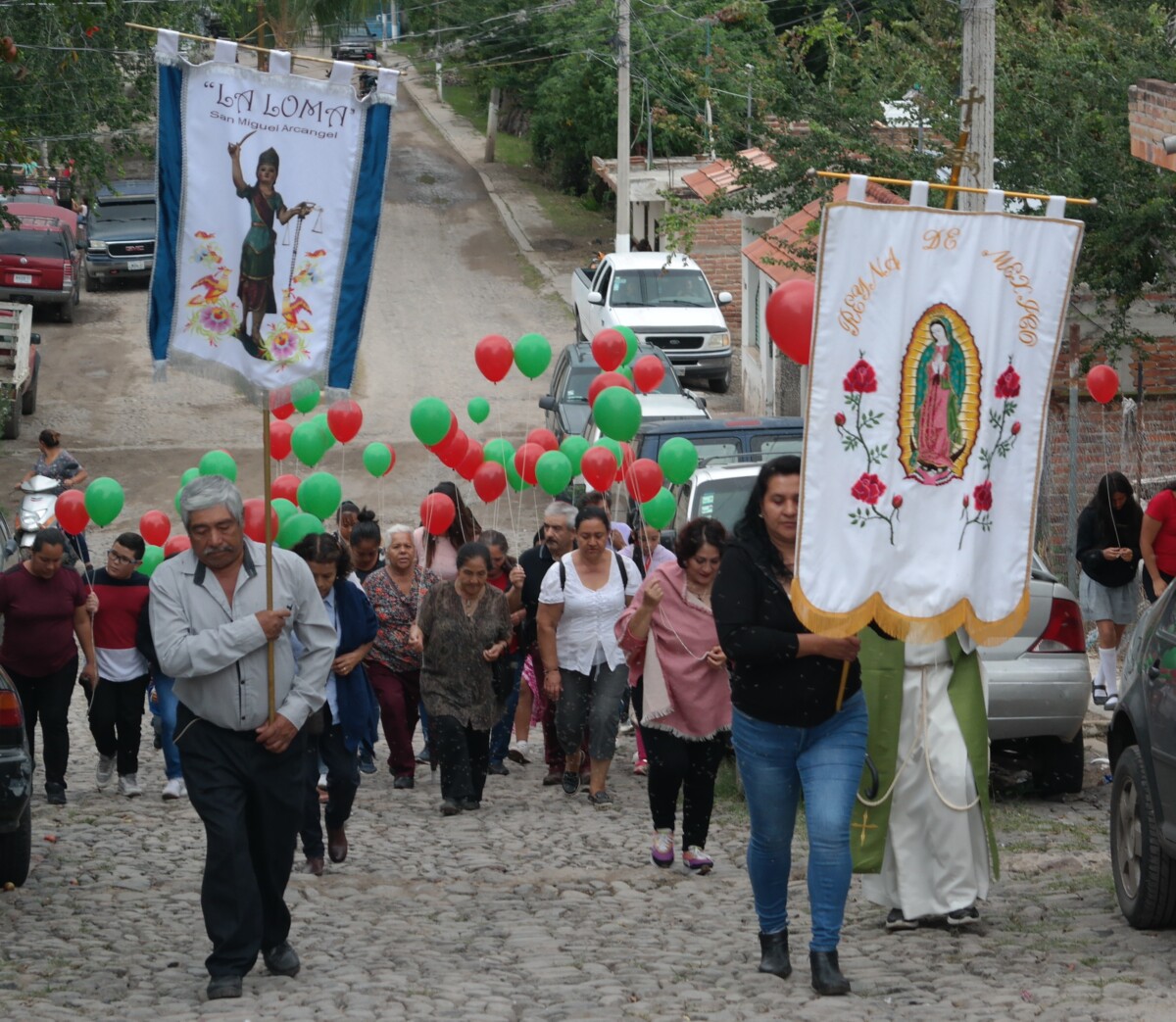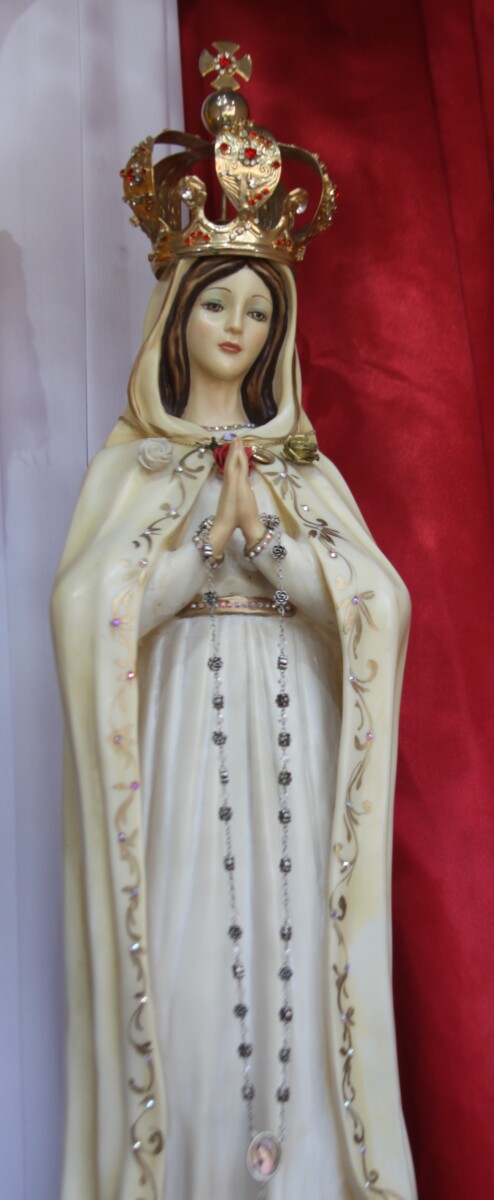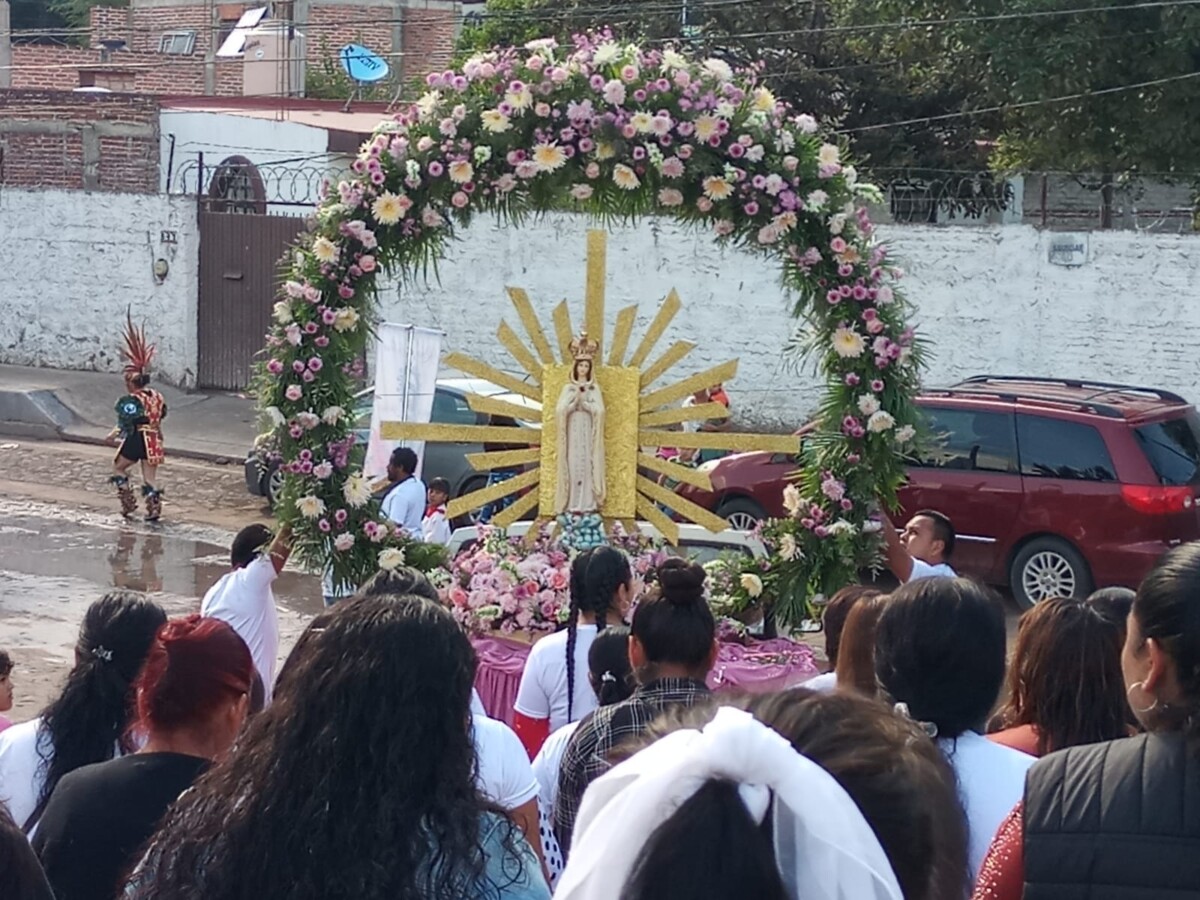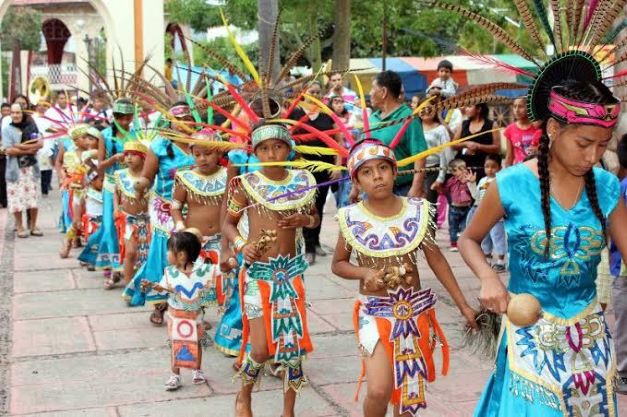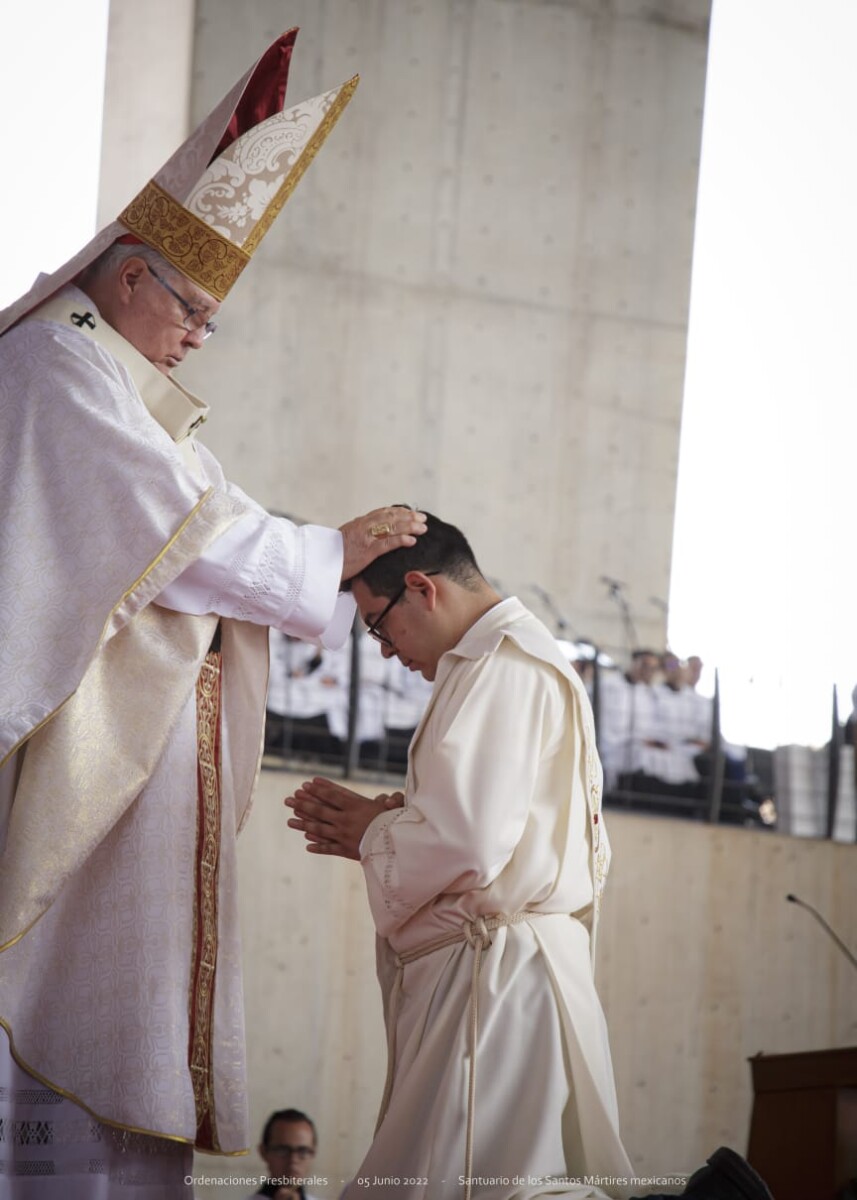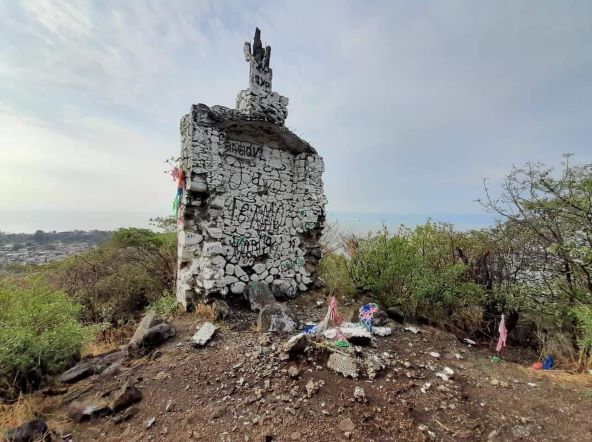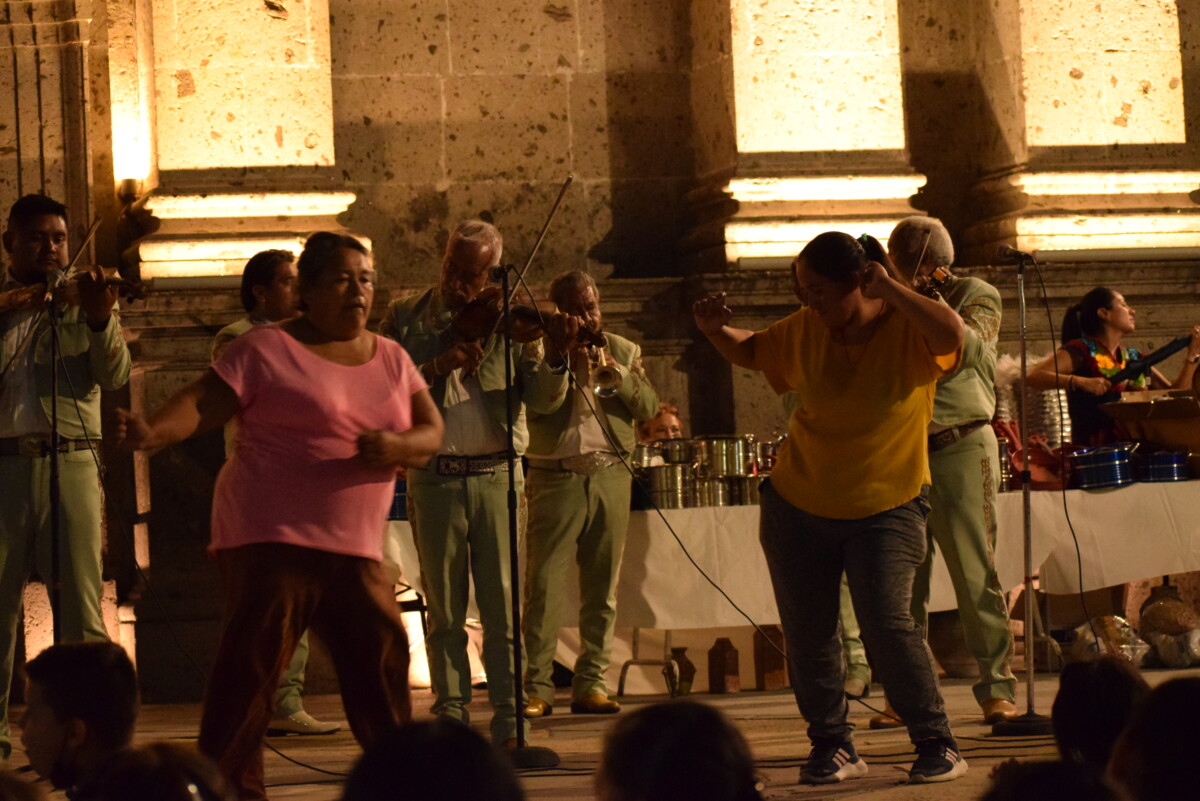religión
Inician festejos de San Miguel en La Loma
Peregrinación rumbo a la agencia municipal de La Loma. Foto: Armando Esquivel.
Armando Esquivel.- Los festejos en Honor a San Miguel, en La Loma, agencia perteneciente a Jocotepec, arrancaron el 19 de septiembre, para concluir el día 29, realizando una procesión con la imagen.
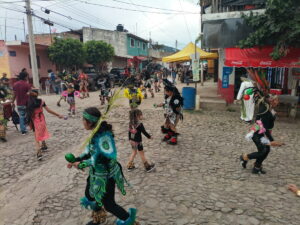
Los danzantes estuvieron presentes en los festejos. Foto: Armando Esquivel.
Los festejos cuentan con peregrinaciones a cargo de diversas familias y barrios de La Loma y la cabecera, caminando por las calles decoradas en rojo y verde con danzantes, música de banda y pirotecnia para llegar a la capilla de San Miguel Arcángel y realizar una ceremonia religiosa.
Las actividades diarias inician a las 6:30 de la mañana, con el rezo de un Rosario de Aurora, para seguir a las siete con una misa; mientras que por las tardes se realizan las peregrinaciones y misas vespertinas. San Miguel es uno de los siete arcángeles y está entre los tres cuyos nombres aparecen en la Biblia: Miguel, Gabriel y Rafael. La Santa Iglesia da a San Miguel el más alto lugar entre los arcángeles y le llama “Príncipe de los espíritus celestiales”, “jefe de la milicia celestial”.
CRÓNICAS DE LA RIBERA
La imagen de la Rosa Mística que se celebra cada 13 de julio. Foto: María Reynozo.
Por Maria del Refugio Reynozo Medina.- Cuando Alexis Daniel Ramos estuvo frente a la imagen de la virgen, sus brazos y rostro se cubrieron de una fina escarcha. Su amigo Omar lo alertó acerca de lo que para muchos significan bendiciones recibidas, cuando se acude a la virgen María, en la advocación de Rosa Mística, con fervor.
Desde niño, recuerda los rezos del rosario con su bisabuela, que era muy religiosa y devota además de San Miguel Arcángel. Cuando en la letanía, pedían a la Rosa Mística “rogad por nosotros” en Alexis había un sentimiento especial.
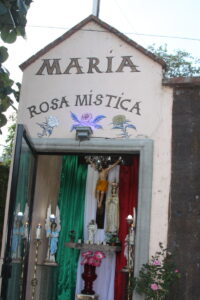
La capilla dedicada a María Rosa Mística en el barrio de El Puente en Jocotepec. Foto: María Reynozo.
En una ocasión tuvo un problema grave, y su amigo le regaló la imagen que lo había impresionado; con ella superó su problema y comenzó a quererla mucho; la tenía en su habitación y le oraba todos los días, comenzó a ver cómo algunos espacios se cubrían de ese polvo brillante finísimo. Pero sobre todo, los milagros que recibía de ella, no solo él sino los vecinos que comenzaban a conocer a la imagen.
En 2016 compró una imagen más grande y poco a poco fueron sumándose los devotos a María Rosa Mística. Hace dos años le construyó un pequeño nicho de poco menos de dos metros cuadrados, desde ahí la imagen que mide unos noventa centímetros de altura aparece vestida de un color marfil con las manos unidas sosteniendo un rosario. En el filo de su manto lleva unos detalles dorados adornados con piedras de brillo tornasol; y sobre el pecho, tres rosas, una blanca, una roja y una dorada. Lleva en la cabeza una reluciente corona con brillantes piedras rojas y blancas.
Las cortinas, los floreros y las veladoras encendidas envuelven el pequeño espacio que invita a la oración. La veneración a la Rosa Mística creció tanto que, Alexis trajo otra imagen a la que le llama peregrina, porque visita las viviendas; sesenta familias son las que conforman la lista de espera para que visite sus hogares y permanezca ahí por una semana. Así el grupo de fieles lleva a la imagen a cada lugar entre rezos y cantos, cuando los lugares son más distantes, Alexis la lleva en su moto.
El barrio que algunos conocen como “El Puente”, en Jocotepec, es testigo del fervor que muchas personas profesan por la imagen cuyo origen es Montichiari, una pequeña ciudad italiana que alberga el santuario de la imagen mística.
En la memoria de los habitantes de este barrio se guarda la historia de un hombre sentenciado a una amputación de piernas por parte de los médicos.
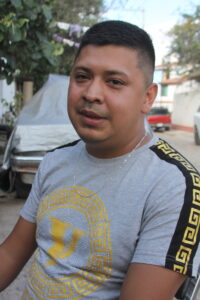
Alexis Daniel Ramos lleva siete años celebrando a la imagen; en su propio espacio erigió una pequeña capilla para rendirle culto.
Cuando estaba en el hospital, una noche advirtió una delicada silueta que le tocó las piernas. No pasa nada, escucho una voz en su interior. Al día siguiente su hija le dijo –tienes una visita muy importante en casa, papá-.
Salieron de ese hospital en busca de otro diagnóstico, inexplicablemente en ese otro lugar, los médicos le dijeron que no requería esa intervención. Salió del hospital directo a comprar un ramo de rosas para el encuentro con la imagen que ya lo esperaba en casa. También le obsequió una medalla que tenía guardada para una ocasión especial.
En el barrio de El Puente se guardan muchas historias como esta, y cada 13 de julio, fecha en que se celebra a María Rosa Mística, unas doscientas personas se dan cita para cantar, rezar y llevarla en procesión por las calles principales del centro de Jocotepec.
Por cada una de sus fiestas, cuelga un rosario de la pared; hay siete que significan los siete padrinos que ha tenido y que ofrendan el rosario de cada aniversario.
A esta pequeña capilla, llegan de pronto personas desconocidas en busca de un milagro y de la veneración; algunos dicen percibir un suave aroma de rosas, aun con la ausencia de esas flores, otros la fina escarcha sobre su cuerpo, lo que para Alexis no es otra cosa que las bendiciones de esa rosa misteriosa.
Peregrinó la Rosa Mística por Jocotepec
Peregrinación al entrar a la delegación de Nextipac. Foto: Laguna.
Redacción.- El Barrio del Puente, en Jocotepec y fieles de la religión católica, salieron a las calles de Nextipac y Jocotepec para venerar a María Rosa Mística, durante su día, el 13 de julio.
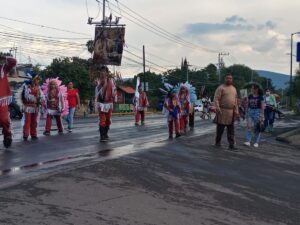
Danzantes que acompañaron a la imagen.
María Rosa Mística peregrinó con la banda, misma que con música de viento, interpretó melodías religiosas; mientras al frente, dos personas arrojaban “cuetes” al cielo para anunciar el paso de la imagen por las vialidades de Nextipac y Jocotepec, mientras que detrás de ellos iba un grupo de danzantes.
La imagen iba sobre un vehículo adornado, contando con un arco de flores que rodeaba a la Rosa Mística, luciendo también un adorno floral en la parte baja; detrás de ella, iban los peregrinos rezando.
El templo principal se encuentra en Montichiari, Italia y es llamado Templo de María Rosa Mística, pero se conoce como Fontanelle, debido a que hay una fuente pequeña. La veneración es el 13 de julio, ya que según Pierina Gilli, mujer que presenció su aparición, esa fue la fecha en que le pidió ser conmemorada.
San Juan Cosalá Patron Saint Festivities have begun
Daily pilgrimages are usually accompanied by dances. Photo: Courtesy.
Alma Serrano (San Juan Cosalá).- For the second consecutive year after the pandemic, residents of San Juan Cosalá celebrated the Patron Saint Festivities in honor of San Juan Bautista, which will last from June 15 to 25.
According to the religious program, every day of the novena there will be an aurora rosary at 6:00 in the morning; while in the evening, the mass after the pilgrimages will be at 7:00. Finally, at 8:00 in the evening there will be serenades.
On June 16 and 18 were Confirmations and First Communions officiated by the Episcopal Vicar.
On June 23rd there will be the «Entrada de cera,» the entrance of the artisan wax candles. On the 24th there will be mass at 7:00 in the evening and the fireworks castle will be burned at 9:00 at night.
On Saturday, June 25 there will be the traditional procession with the restored image of the saint from the church to the boardwalk at 7:45 pm, and the thanksgiving mass to end the festivities will be at 8:30 pm.
Translated by Kerry Watson
Regresa la Virgen de Zapopan al Lago de Chapala
La Generala visitará Chapala para bendecir el lago el domingo 10 de julio. Foto: Archivo.
Redacción.- Bajo el lema “Custodia nuestra Vida entre tus brazos”, la Virgen de Zapopan visitará Chapala este domingo 10 de julio.
La visita 67 de la Generala al Lago de Chapala dará inicio a las 10:30 de la mañana con la recepción de la imagen en en la entrada del municipio por la carretera a Guadalajara, a la altura de la gasolinera.

Programa de la visita 67 de la Virgen de Zapopan a Chapala. Foto: Facebook.
De ahí, la Virgen será trasladada en un carro alegórico hasta el malecón, donde a las 11:30 se hará la bendición del lago en la espera de un buen temporal de lluvias, para posteriormente celebrar la Eucaristía en la parroquia de San Francisco de Asís, ceremonia que será presidida por el Cardenal Francisco Robles Ortega.
El lunes 11 de julio a las 09:30 a.m. la Virgen de Zapopan navegará por las aguas del Lago de Chapala para visitar la Isla de los Alacranes.
Luego del recorrido, la Generala regresará a la parroquia alrededor de las 12:00 del mediodía y las 04:00 de la tarde se celebrará la misa de despedida. Finalmente, a las 04:45 se cantará el Salve para iniciar su retorno a la Basílica de Zapopan.
Ordained as a priest after 15 years of studies
Ceremony in the Sanctuary of the Martyrs of Christ the King.
After 15 years of studies and missions that included Jocotepec, Angel Gabriel Hernandez Beas was ordained as a priest in a ceremony held at the Shrine of the Martyrs of Christ the King in Tlaquepaque on June 5.
Father Hernandez shared his pleasure about his stay in Jocotepec. In 2015 he was in the town along with other companions in the neighborhood of El Carrizal, located in the northern part of town. This was where he gave service with talks and support to the community. The home of the Palmeros Suarez family served as a meeting center.
Father Angel commented that he began his clerical studies at a very young age, and said that it was with time that he discovered that being a priest was his passion. He attended a boarding school in high school, and it was almost at the end of high school when he realized that serving God and the community was his calling.
At the age of 26, Hernandez Beas, a native of Guadalajara, was ordained as a priest. The newly ordained priest commented that on the day of his ordination he felt very nervous, but when he left the subway part of the religious precinct, he noticed that the place was full and that brought down his nervousness, and he was suddenly joyful.
In the 15 years he spent in preparation, Father Angel recalls an experience he says he will never forget. During a mission, he was visiting a marginalized neighborhood in order to distribute food to help the most vulnerable population. This caught the attention of a woman who began to record this good deed with her phone. After a few days, one of the people who gave assistance received the video, showing it with astonishment to Angel. On the video screams and moans were heard, which did not occur at the time of the incident. This caused his good deed to be turned into a complaint against the volunteers although the sounds may have been edited in later.
Father Angel was assigned to the parish Jesus Christ King of the Universe, located in the Miramar neighborhood in Zapopan, and in less than a month he will be officiating religious ceremonies.
«Never stop having hope and trust in priests. Come closer, get to know us, so that we realize that you are not extra-normal, bitter or distant people, but that you can find a good friend,» concluded the priest during the interview.
Translated by Christalle Dalsted
The legend of the sleeping dragon and the mythical Cross on San Miguel Hill
The symbolic cross fell after a strong storm, now only the base can be seen. Photo: Gilberto Padilla.
Jazmín Stengel (Chapala).- A strong storm on June 9 knocked down the legendary Cross of San Miguel Hill in Chapala. Legend says if this happens, there will be no protection to keep the dragon asleep.
For hundreds of years, the locals considered San Miguel hill, across from the municipal capital’s main plaza, a place where evil hides. Rubén Pulido Hernández, author of the book “Chapala entre las Fábulas y Leyendas” (Chapala’s Fables and Legends), says that’s why there are traces of ancient civilization only at the foot of the hill itself, not at the top.
According to Pulido, the ancient natives and the first Franciscan missionaries who arrived in the Chapala area around 1524, sometimes saw flames on the hill. That prompted numerous legends.
Hundreds of years later, Pulido said, a geologist discovered minerals and gasses on the hill that are flammable when in contact with oxygen. That’s what caused the fires to be visible at night.
According to the legend, the greatest friar of the Franciscan order decided to go up the hill and fight this fire-breathing demon. Upon reaching the top of the hill, which is not very high, the missionary built a hermitage just above where gasses or minerals came out. This somehow managed to prevent the fire from “appearing” out of nowhere. To honor this father who “defeated the devil” and lived to tell the tale, the first cross was placed on the hill of San Miguel, probably made of wood.
The date of its construction has not yet been determined. Local inhabitants estimate that it was between 1920 and 1930, made of stone and cement. It fell before it was a hundred years old.
Over time that belief became the legend of the sleeping dragon. Some believe that the hill is hollow, and a river of thermal water flows at the bottom of its entrails. Others think it is a volcano that never erupted. But what they all share is that the cross symbolizes protection.
The shape of the Dragon
Sailors on Lake Chapala used the hills as a reference and began to say that it has the shape of a dragon. The tip of San Miguel Hill is the head and the body continues between what is now the area of Riberas del Pilar and the Ajijic Highway.
The cross symbolized a sword stuck in the head of the beast, which kept it still so that it could not harm the people. “The interesting thing is to know what is going to happen now,” asked Rubén Pulido.
Translated by Mike Rogers


Chronicles of the Ribera
The image of San Antonio de Padua that a mysterious woman left more than a hundred years ago in the hands of Feliciana Carrillo. Photo: María del Refugio Reynozo.
By María del Refugio Reynozo Medina
They say that Saint Anthony of Padua helps you find what was lost and remember what was forgotten. Benita Lomelí Hernández grew up wrapped in the fervor of a 15-centimeter tall sharp-faced figure, which has belonged to her family since before she was born.
The origin of this small sculpture dates back more than a hundred years. In the town of El Sauz in the municipality of Jocotepec, Benita’s grandmother, Doña Feliciana Carrillo was in the courtyard taking the afternoon’s last sun, with a view of the road that crossed the town. In the distance, she could see the silhouette of a woman approaching.
The woman, after greeting Doña Feliciana, asked her if she would hold the package she was carrying. The woman told Doña Feliciana that she was on her way to San Luis Soyatlán, but that she would soon return for the package. Doña Feliciana could not see the woman’s face clearly as she wore a shawl covering her head and walked slowly. When Doña Feliciana’s daughter came out, she told her daughter what had happened. No one else could see the mysterious lady.
The small package fit in both hands and was wrapped in worn, time-stained scraps of cloth. “Take it up to the roof,» she asked her daughter, with a tone of respect for other people’s things. A few months passed, the woman did not return, and everyone forgot about the package.
Doña Feliciana’s house was the meeting point for personalities who sporadically passed through the village. It was a very remarkable house because it no longer had a dirt floor inside: it had cobblestones, tiles and a fireplace. On one occasion when a priest arrived to do evangelization work, Doña Feliciana remembered the package that the woman had given her to keep and that she had never dared to open. With the priest as a witness, they took the package down from the attic.
The parish priest was removing the layers of battered cloth one by one until a fine figure was revealed. “It is St. Anthony of Padua,» he told them. “What was lost and forgotten will return when they implore him to do so.”
Doña Feliciana was impressed, for her the image was alien. “Take care of it, it is yours,» the father told her. He also asked Doña Feliciana to celebrate it every June 13. “That woman will not come back,» he told them with certainty.
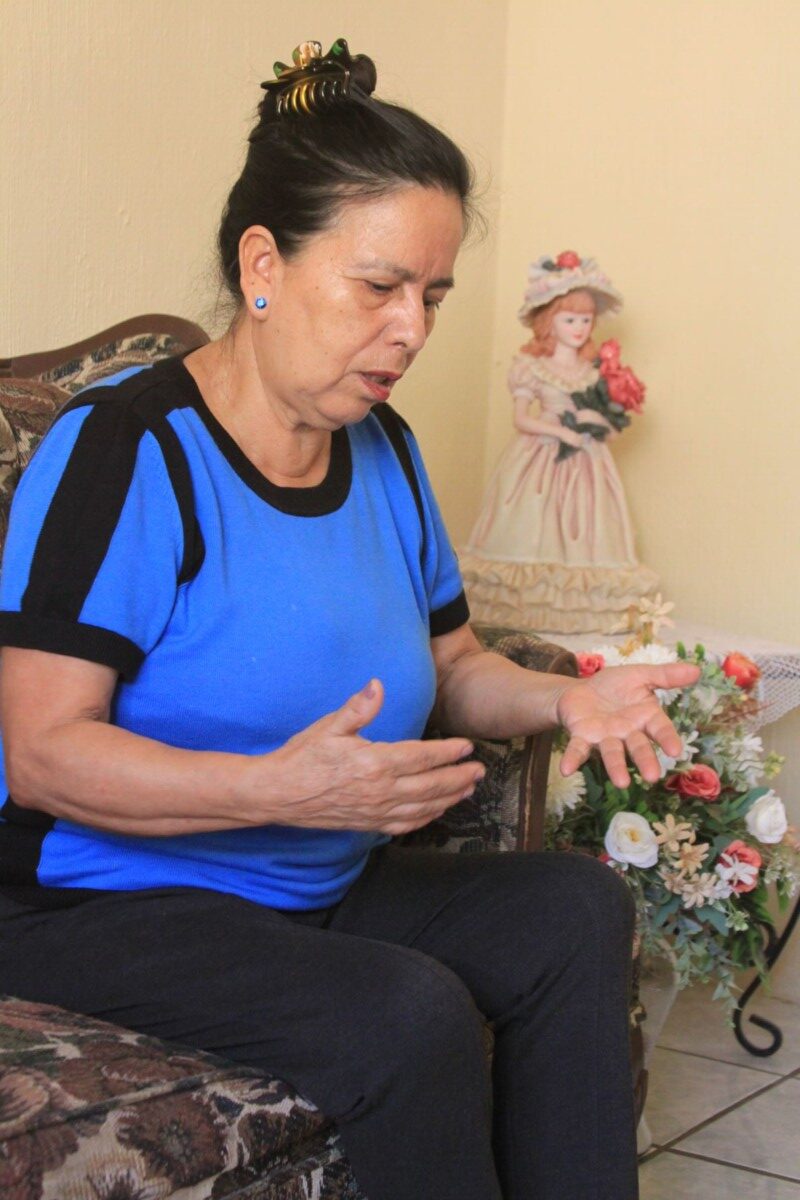
Benita Lomelí Hernández talks about how the image of San Antonio de Padua, now venerated by her entire family, came to her. Photo: María del Refugio Reynozo.
Some said that the person who gave the precious image to Doña Feliciana was not from this world. She never appeared again, and no one else besides Feliciana could ever see her. Her presence was a mirage, but the fine figure of St. Anthony of Padua was real. From the moment he was discovered among the cloth rags, Benita’s grandmother entrusted the image to her youngest son, who was then three years old.
When that three-year-old boy came of age and got married, his brothers came to give him the oxen, goats and corn cribs after the three days of the wedding. “You will know if you take care of your capital,» they said. Along with this, they also gave Benita’s father the sculpture of San Antonio, as was his mother’s wish.
That is how Benita grew up, with the veneration of the saint professed by her parents who guarded the image that came from who knows where. That faith spread to the neighbors who began to visit Benita’s house to pray for their lost causes and then to carry candles in gratitude for all that was found.
Benita remembers a prayer said by her mother:
Antonio, Antonio, in Padua you were born, in Padua you were raised, you went to school, your prayer book was thrown away, your father found it for you. Antonio, Antonio, the lost is found and the past is remembered. Antonio, Antonio forever. AMEN.
The image of Saint Anthony that Benita now keeps is made of a single piece of wood, carved by unknown hands. The statue’s facial features are fine, at the waist of his Franciscan habit he wears a tight cord, and in his arms he carries a child of barely four centimeters in length.
This particular little boy was bought by Benita’s mother, who has lost count of the number of children replaced because the original was stolen. “They stole my child again,» she would say to the sales clerks at the religious articles store when she went to replace the small statue. “They think he will bring them a boyfriend, but St. Anthony does not give boyfriends,» she said. “[For] good husbands one must ask St. Joseph.”
Every June 13, in Benita’s house, candles are lit and fresh flowers are placed in honor of the little image full of history that brings back what was lost and reminds us of what was forgotten. And Benita along with those of the faithful neighbors invoke the Saint of Padua:
Antonio, Antonio, Antonio…
Translated by MaryAnne Marble
More than 300 people attended the Adolfo Rayo Festival on Mother’s Day
Chapala moms had fun dancing in the atrium of the San Francisco de Asís parish during the contest. Photo: Jazmín Stengel.
Jazmín Stengel (Chapala).- With an attendance of just over 300 people, the Adolfo Rayo Festival was held in the atrium of the parish of San Francisco de Asís in Chapala. The festival was held to celebrate mothers on their day, with prizes such as kitchen utensils given away, and entertainment provided by the Mariachi Águila de Chapala.
During the celebration, dance contests were held for the mothers, where everyone won a prize. Numbered tickets were also given out for the awarding of prizes such as frying pans, express pots, blenders, and buckets, among many other household items.
Translated by Rebecca Zittle
Two caught for robbery in Chapala parish church
The crime for which they were captured occurred last week and according to the investigations these people entered the church of San Francisco de Asis
Laguna Staff (Chapala,Jal.).- Two men were arrested after being accused of stealing more than 6 thousand pesos from a church in Chapala. Personnel from the Regional Prosecutor’s Office placed them at the disposal of the judges who served them with an arrest warrant for the crime of aggravated robbery.
They are Yahir Alejandro G. and Víctor Alfonso C., who were arrested on Isla del Presidio street at the intersection with De los Maestros, in the Gastronómica neighborhood, in the municipality of Chapala.
The crime for which they were captured occurred last week and according to the investigations these people entered the church of San Francisco de Asis, forced open a box of coins that was at the foot of a catholic image and extracted the amount of 6 thousand pesos, the cause of their arrest warrant.
Both were placed at the disposal of the Judge of Control and Oral Trial of the Fifth Judicial District, who will decide their legal situation. The arrested persons will be treated as innocent until a sentence is issued against them.
Translated by Patrick O’Heffernan
© 2016. Todos los derechos reservados. Semanario de la Ribera de Chapala
